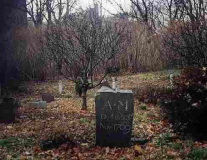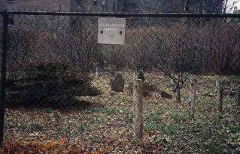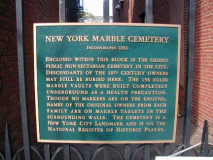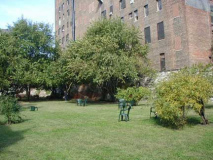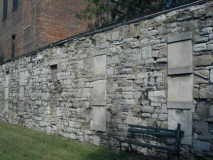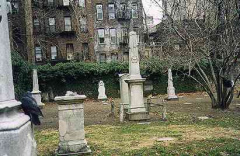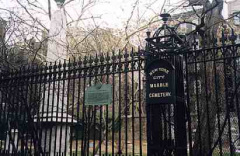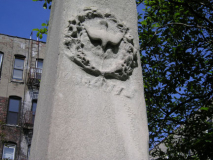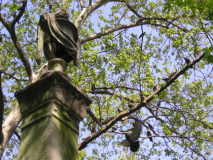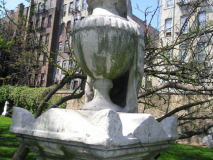Scattered throughout New York City are several small cemeteries. In the 1800s, a law was passed that prohibited further cemetery construction on the island of Manhattan, owing to the city’s rapid growth. Subsequently, many cemeteries began to appear in western Queens, which was close to the city.
However, remnants and vestiges of several old cemeteries are still to be found in Manhattan, as well as several small plots in Brooklyn, Queens and the Bronx. Some are privately owned, and some are affiliated with churches.
The smallest cemetery in Brooklyn, the Revolutionary Cemetery in Bay Ridge, at the corner of Narrows Avenue and Mackay Place, is the resting place of members of the Barkaloo family.
Moore-Jackson Cemetery, on 54th Street near 31st Avenue in Woodside, Queens, was established adjacent to the farmhouse of the Moore family on Bowery Bay Road (today’s 51st Street), which was built early in the 18th Century. The old farmhouse stood until 1901. The burial plot itself dates at least to 1733, which is the date of the earliest recorded stone. The earliest gravestone that is actually legible is shown above: “A.M. (Augustine Moore), dyed the 23rd Nov. 1769” (records show that Augustine was only 17 when he died); the latest burial took place in 1867.
Over the years, the burial ground fell into neglect. By the 1920s it was no longer maintained and was being used as a garbage dump. In the Thirties, workers from a nearby greenhouse refurbished the cemetery, restoring fallen stones and installing a chain link fence. Later that decade, though, the plot again became neglected. It wasn’t until the 1990s that a concerted effort was made to make the old burial ground a landmark! It is a reminder of bustling Woodside’s colonial past.
Information for the above pictures comes from Woodside, A Historical Perspective 1652-1994, by Catherine Gregory, published by Woodside On The Move 1994
There are two New York Marble Cemeteries on the Lower East Side. This one is accessible only from a gate on 2nd Avenue between 2nd and 3rd Streets. It’s not open to the public. Unusually there are no headstones: the interred are identified by inscriptions on inlaid tablets on the perimeter wall.
There are no headstones in the New York Marble Cemetery; instead, lawn chairs are the rule. Vaults are marked by tablets on the perimeter walls. Interments are below ground.
The other Marble Cemetery is on 2nd St, between 1st and 2nd Avenues. President James Monroe was briefly interred here. Also owning a vault is one Preserved Fish. “Preserved” is a venerable Quaker name, and there are a lot of Fishes in New York State.
Forgotten Fan Joe Brennan reports that the two Marble Cemeteries are separate entities and are not connected in any way:
New York Marble Cemetery, 1830, www.marblecemetery.org, and New York City Marble Cemetery, 1832, www.nycmc.org, are not two locations of the same cemetery, but separate organizations! The web sites each list the other, helpfully, but one senses an old rivalry and a delicate truce, as the links do not give the proper name of the other place but just the identical wording “Other Marble Cemetery” without further comment on the striking coincidence of another “marble cemetery” being so close by.
Anne Brown of the New York Marble Cemetery (the one on 2nd Avenue) recently responded to Joe’s observations in a message to your webmaster.
Joe Brennan is correct in his separation of the two cemeteries. I chuckled when I read that we were rivals. Leave it that way – it makes good copy. The reason that we don’t name each other on the links on our web sites is because the names would mean nothing – it’s the fact that there are two of us to consider, if you’re looking for ancestors, that’s important.
EVERYONE, including the owners, gets the names mixed up. Why on earth the Other Cemetery (!) wasn’t given a distinct name to begin with is beyond me. The earliest newspaper description that I’ve found, 1836, gets the names backwards. You’d think that there would be a 50-50 chance of getting them correct, but it rarely happens.
One other change – the perimeter wall is is a rubble wall made of stone and marble, not brick.
This is the churchyard of the Staten Island Reformed Church on Port Richmond Avenue, just off Richmond Terrace.The stone in front center dates to 1745. The present church building was constructed in 1844, but it replaced three previous churches dating back to 1663!
The other two cemeteries belonging to the synagogue are in Chinatown and Greenwich Village [see below].
This is the First Cemetery of Spanish-Portuguese Synagogue, Shearith Israel, at St. James Place just off Chatham Square in Chinatown. This cemetery dates to 1683! The Shearith Israel Jews emigrated from Brazil beginning in the mid-17th Century.
Hidden away on West 11th Street just east of 6th Avenue is the Second Cemetery of Spanish-Portuguese Synagogue, Shearith Israel.
The 11th Street cemetery is much smaller than it originally was. The situation is explained in Willensky and White’s AIA Guide to New York City:
The original Shearith Israel Cemetery is at Chatham Square [see above.] Burials began here, at the 11th Street site, in 1805, in what was a much larger, square plot extending into what is now the street. The Commissioners’ Plan had established the city’s grid in 1811, but not until 1830 was West 11th Street cut through, at that time reducing the cemetery to its present tiny triangle. The disturbed plots were moved further uptown to the Third Cemetery [also see above] on West 21st Street. In 1852 city law forbade burial within Manhattan, and subsequent interments have been made in Queens.
According to legend, the location of the red-bricked building abutting the cemetery has an unusual history of its own. On the site of that building, there was a Civil war tavern known as the “Grapevine”. Many Union officers went there including many southern spies, and many incognito newspaper reporters.
Of course everyone knew that everyone else was evesdropping on converstions there, so the tavern became known as the place where many rumors originated. This became the origin of the phrase “heard it through the grapevine”! The newpapers began using this phrase which is in common use now, and later it made Gladys Knight and Marvin Gaye a lot of money.
1/2/99

